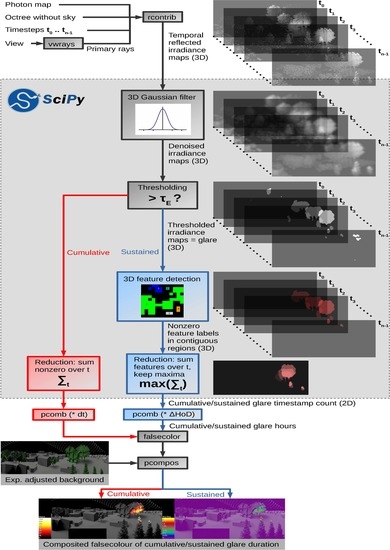Spatio-Temporal Visualisation of Reflections from Building Integrated Photovoltaics
Abstract
1. Introduction
2. Background
2.1. Current Legislation
2.2. Current Technical Guidelines and Assessment Criteria
2.3. PV Reflection Simulation
3. Case Study
4. Simulation Methodology
4.1. Motivation
4.2. Workflow Overview
4.3. General Workflow
4.3.1. Sky Model Generation
4.3.2. Simulation Model Generation
Geometric Model of Church and Surroundings
Candidate PV Material Models
4.3.3. Cumulative PV Reflection Simulation
Photon Map Generation
Rendering
4.3.4. Postprocessing
Absolute Annual Irradiance
Relative Annual Irradiance
4.4. Spatio-Temporal Workflow
4.4.1. Filtering
4.4.2. Thresholding
4.4.3. Feature Detection (Sustained Glare)
4.4.4. Reduction
4.4.5. Visualisation
5. Results and Discussion
5.1. Annual Reflected Irradiance
5.2. Application of Recommended Criteria, Glare Duration
5.3. Practical Applications and Impact
- Assessing proposed PV installations for compliance with regulations by building authorities and urban planners.
- Developing low-glare PV module surfaces by PV manufacturers.
- Defining PV glare assessment criteria, thresholds, and technical guidelines by trade associations.
- Establishing urban regulations concerning PV installations by government agencies.
5.4. Limitations
- While using irradiance as physical metric is convenient to indicate potential glare, it is an integral quantity; as such, it may underrepresent isolated incidents of high radiance/luminance from reflectors subtending very small solid angles within an observer’s field of view. While the resulting glare can even be disabling, such events tend to be of short duration (corresponding to glint), and may not appreciably impact the sustained glare duration.
- The background luminance (and therefore contrast) is not considered.
- The simulation depends on the accuracy and timeliness of the digital terrain model; in particular, vegetation is assumed to be a static, effectively opaque barrier irrespective of season in the case study.
- The PV surface models are derived from new production samples, and do not take weathering or manufacturing tolerances into account.
- While a sunny sky assesses the worst-case scenario, a more realistic assessment would be obtained using a climate-based sky model that accounts for typical cloud cover on site.
- The temporal resolution is currently 15 min, which may be insufficient in detecting high-frequency glare. While the timestep increments can be finer grained, this increases simulation and postprocessing times.
- Timestamp increments are fixed, thus the simulation also expends considerable computational effort on timestamps that contribute negligible irradiance, rather than sampling adaptively.
- The current workflow is static and non-interactive, since the simulation must complete before the results can be assessed.
6. Conclusions and Future Work
- A general workflow to assess cumulative annual irradiance from PV reflection, both in absolute terms and in relation to a reference material in order to compare different candidate PV surface materials.
- A novel, image-based spatio-temporal workflow that applies recommended assessment criteria and thresholds to quantify the cumulative annual glare duration, and the maximum sustained glare duration for any day of the year.
- A PV reflection simulation using data-driven material models of measured BSDFs.
- A digital terrain model of the site providing the urban context of the simulation.
- Photon mapping to efficiently precompute only the reflected component from the PV on the surrounding buildings.
- A falsecolour visualisation of reflected irradiance in the context of the built environment suitable for practitioners, municipal planning authorities and clients of PV installations. Including a background image of the built environment enables identification of potentially affected buildings. Such a visualisation is readily accessible to non-experts as well as practitioners.
- While the satinated PV module exhibits a homogeneous reflection distribution and no potential for glare at all, the standard PV module concentrates its reflections towards the west of the site during summer mornings (see Figure 11).
- The proposed spatio-temporal workflow identifies glare in the west when applying the conservative irradiance threshold of 10 W/m, which translates into an annual glare duration of ca. 100 h (see Figure 14) and a maximum sustained glare duration of 1h for any day of the year (see Figure 15). These exceed the recommended limits of = 50 h and = 30 min, respectively.
- In consideration of the noncritical nature of the identified glare with the standard PV module, both candidates are viable replacements for the current roof. Because the site is heritage protected however, the satinated PV is more suitable in preserving the current appearance of the roof (see Figure 9).
- A comparison with predictions made in an earlier proposal for a PV roof retrofit confirmed that the proposed method indeed complements and supports the expertise of a PV planner (see Figure 13).
- Optimisation of the scripts comprising the spatio-temporal workflow, particularly the memory footprint of the sustained glare extraction, which currently limits it to iteratively processing daily timesteps as the matrices tend to be very large (several gigabytes).
- Improvements to the daylight simulation engine. Progressive photon mapping techniques with visual feedback, for example, would introduce a degree of interaction to the simulations by allowing a planner to identify and react to hotspots early, while the results are still being refined. Currently the simulation runs to completion before the results can be reviewed.
- On a more fundamental level, the light transport algorithm at the heart of the simulation engine should be modified to more efficiently sample adaptively in both the spatial andtemporal domains. The raytracing algorithms currently employed in Radiance do not account for the latter, and annual simulations always use large numbers of fixed timesteps, with few actually contributing significantly to the results (i.e., as detectable glare in the analysis).
- The proposed method should be applied to a more comprehensive suite of extant case studies and recommended criteria, with the goal of refining the latter in terms of how the predicted glare is actually perceived on site.
Author Contributions
Funding
Acknowledgments
Conflicts of Interest
References
- Danks, R.; Good, J.; Sinclair, R. Assessing reflected sunlight from building facades: A literature review and proposed criteria. Build. Environ. 2016, 103, 193–202. [Google Scholar] [CrossRef]
- Jakubiec, J.A.; Reinhart, C.F. Assessing Disability Glare Potential of Reflections from New Construction: Case Study Analysis and Recommendations for the Future. Transp. Res. Rec. 2014, 2449, 114–122. [Google Scholar] [CrossRef]
- Carlucci, S.; Causone, F.; Rosa, F.D.; Pagliano, L. A review of indices for assessing visual comfort with a view to their use in optimization processes to support building integrated design. Renew. Sustain. Energy Rev. 2015, 47, 1016–1033. [Google Scholar] [CrossRef]
- Henley, J. From the Walkie Talkie to the Death Ray Hotel: Buildings Turn up the Heat. The Guardian. 3 September 2013. Available online: https://www.theguardian.com/artanddesign/shortcuts/2013/sep/03/walkie-talkie-death-ray-buildings-heat (accessed on 12 July 2018).
- Burbank, L. L.A.’s Disney Hall Shines–A Bit Too Brightly. National Public Radio Inc., 2005. Available online: https://www.npr.org/templates/story/story.php?storyId=4541963 (accessed on 12 July 2018).
- Hayward, M. Airport Controllers Complain of Solar Panels’ Glare. New Hampshire Union Leader. 30 August 2012. Available online: http://www.unionleader.com/article/20120830/NEWS02/708309966 (accessed on 12 July 2018).
- Bohren, A. Blendung von Solaranlagen: Übersicht zur aktuellen Rechtslage. In Proceedings of the Symposium Thermische Solarenergie, Bad Staffelstein, Germany, 6–8 May 2015; OTTI: Bad Staffelstein, Germany, 2015. Available online: http://www.spf.ch/fileadmin/daten/publ/Bohren_Blendung.pdf (accessed on 12 July 2018).
- 20min.ch. Solaranlage Darf Nachbarn Blenden. 20 Minuten, 7 March 2012. Available online: http://www.20min.ch/schweiz/news/story/Solaranlage-darf-Nachbarn-blenden-20629849 (accessed on 12 July 2018).
- Battaglia, G. Grauer Star Wegen Solarpanel. Blick, 15 May 2017. Available online: https://www.blick.ch/news/schweiz/geblendet-von-nachbarin-marlis-lauffer-traut-sich-bei-schoenem-wetter-kaum-noch-in-den-garten-grauer-star-wegen-solarpanel-id6663759.html (accessed on 12 July 2018).
- Bundesversammlung der Schweizerischen Eidgenossenschaft. Bundesgesetz über die Raumplanung (Raumplanungsgesetz) RPG; SR 700. 2018. Available online: https://www.admin.ch/opc/de/classified-compilation/19790171/index.html (accessed on 6 March 2018).
- Der Schweizerische Bundesrat. Raumplanungsverordnung RPV; SR700.1. 2016. Available online: https://www.admin.ch/opc/de/classified-compilation/20000959/index.html (accessed on 6 March 2018).
- Reichenbach, A.; Baumann, J.; Hofmann, D.; Nötzli, J.; Vonlanthen, J.; Wyss-Käppeli, B. Vollzugshilfe Lichtemissionen. Technical Report P282-1581. Bundesamt für Umwelt BAFU, 2017. Available online: https://www.bafu.admin.ch/bafu/de/home/themen/elektrosmog/fachinformationen/lichtemissionen--lichtverschmutzung-/konsultation-vollzugshilfe-lichtemissionen.html (accessed on 28 March 2018).
- LAI. Hinweise zur Messung, Beurteilung und Minderung von Lichtimmissionen. Technical Report. Bund/Länder-Arbeitsgemeinschaft für Immissionsschutz (LAI): Potsdam, Germany, 2015. Available online: https://www.lai-immissionsschutz.de/documents/hinweise_1503575680.pdf (accessed on 26 January 2018).
- Stickelberger, D.; Moll, C. Leitfaden Solaranlagen. Technical Report, Swissolar, Schweizerischer Fachverband für Sonnenenergie, Zürich, Switzerland. 2017. Available online: http://www.swissolar.ch/fileadmin/user_upload/Shop/170707_Leitfaden_RPG_Langfassung.pdf (accessed on 26 January 2018).
- Ho, C.K.; Ghanbari, C.M.; Diver, R.B. Hazard Analyses of Glint and Glare from Concentrating Solar Power Plants. In Proceedings of the SolarPACES; AIP: Berlin, Germany, 2009; Available online: https://www.semanticscholar.org/paper/Hazard-Analyses-of-Glint-and-Glare-from-Solar-Power-Ho-Ghanbari/dcf8c285917f8b46cff00b0be425481c767deb57 (accessed on 27 March 2018).
- Larson, G.W.; Shakespeare, R. Rendering With Radiance: The Art And Science of Lighting Visualization; Booksurge LLC: Charleston, SC, USA, 2004. [Google Scholar]
- Rose, T.; Wollert, A. The dark side of photovoltaic–3D simulation of glare assessing risk and discomfort. Environ. Impact Assess. Rev. 2015, 52, 24–30. [Google Scholar] [CrossRef]
- Sandia National Laboratories. Solar Glare Hazard Analysis Tool (SGHAT). 2017. Available online: https://share.sandia.gov/phlux (accessed on 27 March 2018).
- Sims Industries. GlareGauge–Comprehensive Solar Glare Analysis. 2018. Available online: https://www.forgesolar.com/tools/glaregauge/ (accessed on 27 March 2018).
- Yang, X.; Grobe, L.; Wittkopf, S. Simulation of Reflected Daylight from Building Envelopes. Proceedings Building Simulation 2013. IBPSA: Chambeéry, France, 2013. Available online: http://www.ibpsa.org/proceedings/BS2013/p_1232.pdf (accessed on 6 March 2018).
- Schregle, R. Development and Integration of the RADIANCE Photon Map Extension. Technical Report. Lucerne University of Applied Sciences and Arts, 2015. Available online: https://www.researchgate.net/publication/272497518_Development_and_Integration_of_the_RADIANCE_Photon_Map_Extension_v112 (accessed on 27 March 2018).
- Kunz, G. Kirchen in Luzern; Baukultur Entdecken; Innerschweizer Heimatschutz (IHS): Luzern, Switzerland, 2009. [Google Scholar]
- Kanton Luzern. Gleodaten-Portal. 2018. Available online: https://geoportal.lu.ch/geodaten (accessed on 16 May 2018).
- Grobe, L.O.; Wittkopf, S.; Kazanasmaz, Z.T. High-resolution data-driven models of Daylight Redirection Components. J. Façade Des. Eng. 2017, 5, 101–113. [Google Scholar] [CrossRef]
- Ward, G.; Kurt, M.; Bonneel, N. Reducing Anisotropic BSDF Measurement to Common Practice. In Proceedings of the Eurographics 2014 Workshop on Material Appearance Modeling: Issues and Acquisition (MAM ’14), Lyon, France, 25 June 2014; Eurographics Association: Aire-la-Ville, Switzerland, 2014; pp. 5–8. Available online: http://dl.acm.org/citation.cfm?id=2855560.2855562 (accessed on 27 March 2018).
- Schregle, R.; Grobe, L.; Wittkopf, S. An out-of-core photon mapping approach to daylight coefficients. J. Build. Perform. Simul. 2016, 9, 620–632. [Google Scholar] [CrossRef]
- Schregle, R. The Radiance Photon Map Manual. 2016. Available online: https://www.researchgate.net/publication/303406111_The_RADIANCE_Photon_Map_Manual (accessed on 16 May 2018).
- Jones, E.; Oliphant, T.; Peterson, P. SciPy: Open Source Scientific Tools for Python. 2001. Available online: http://www.scipy.org/ (accessed on 14 May 2018).

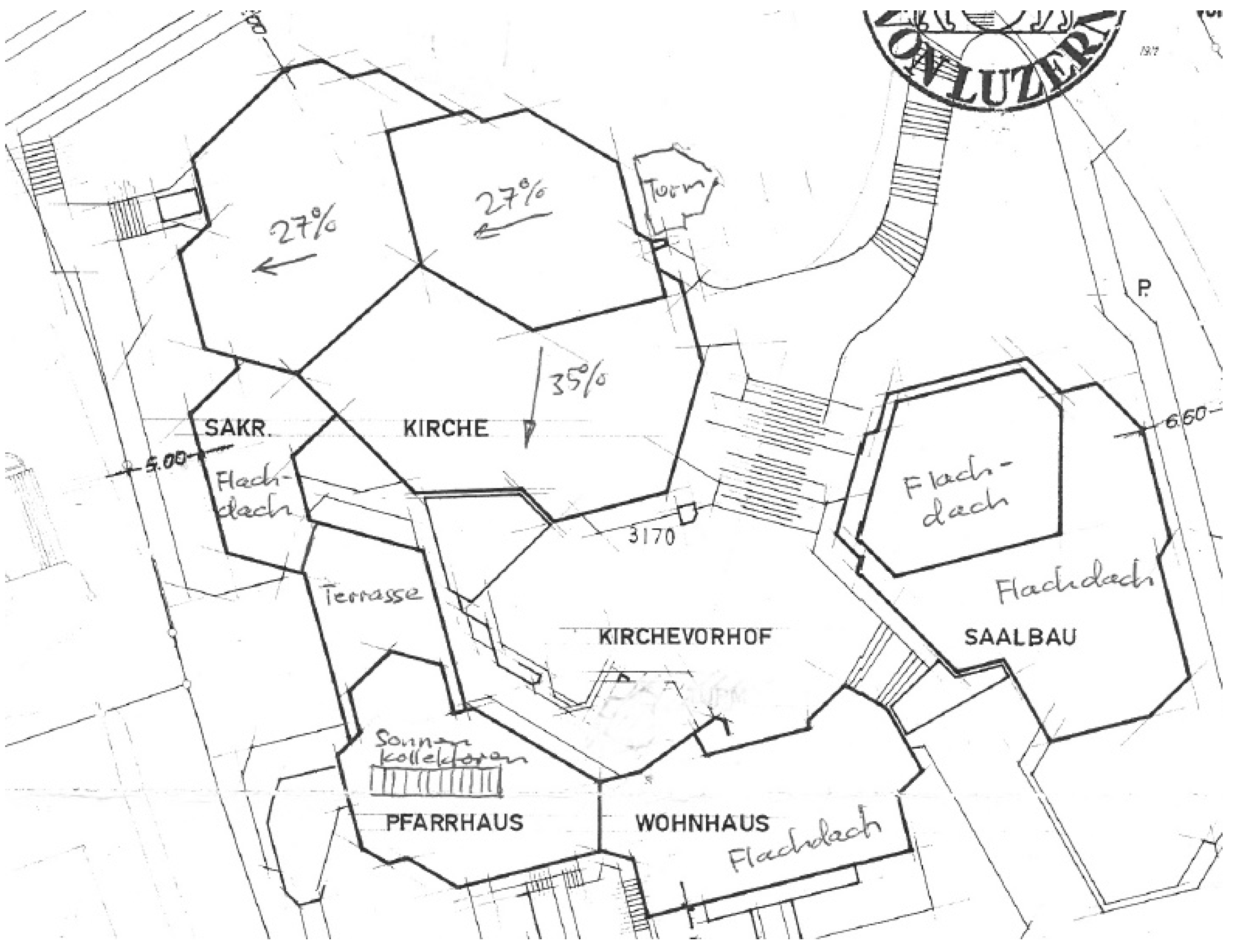
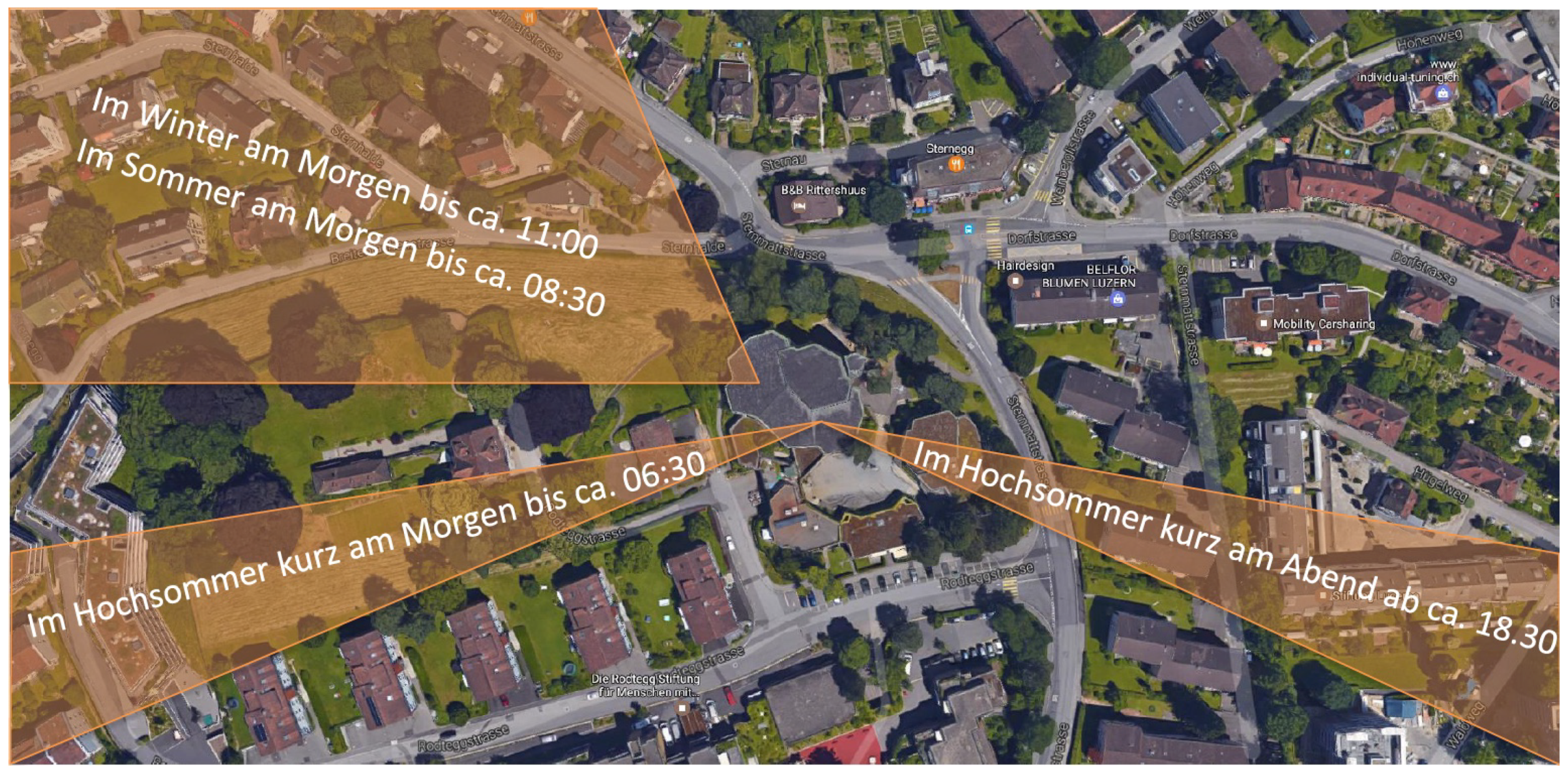
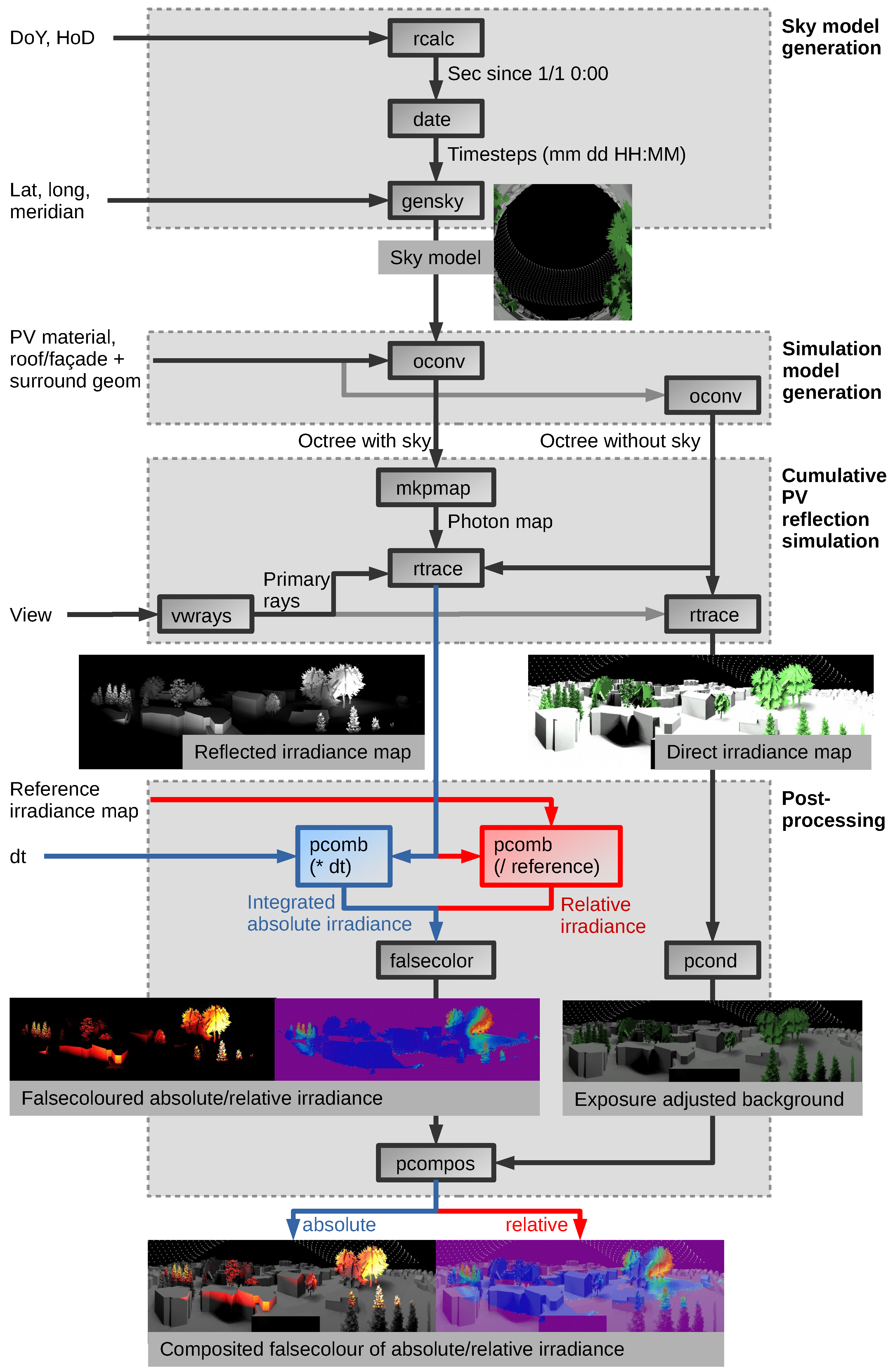
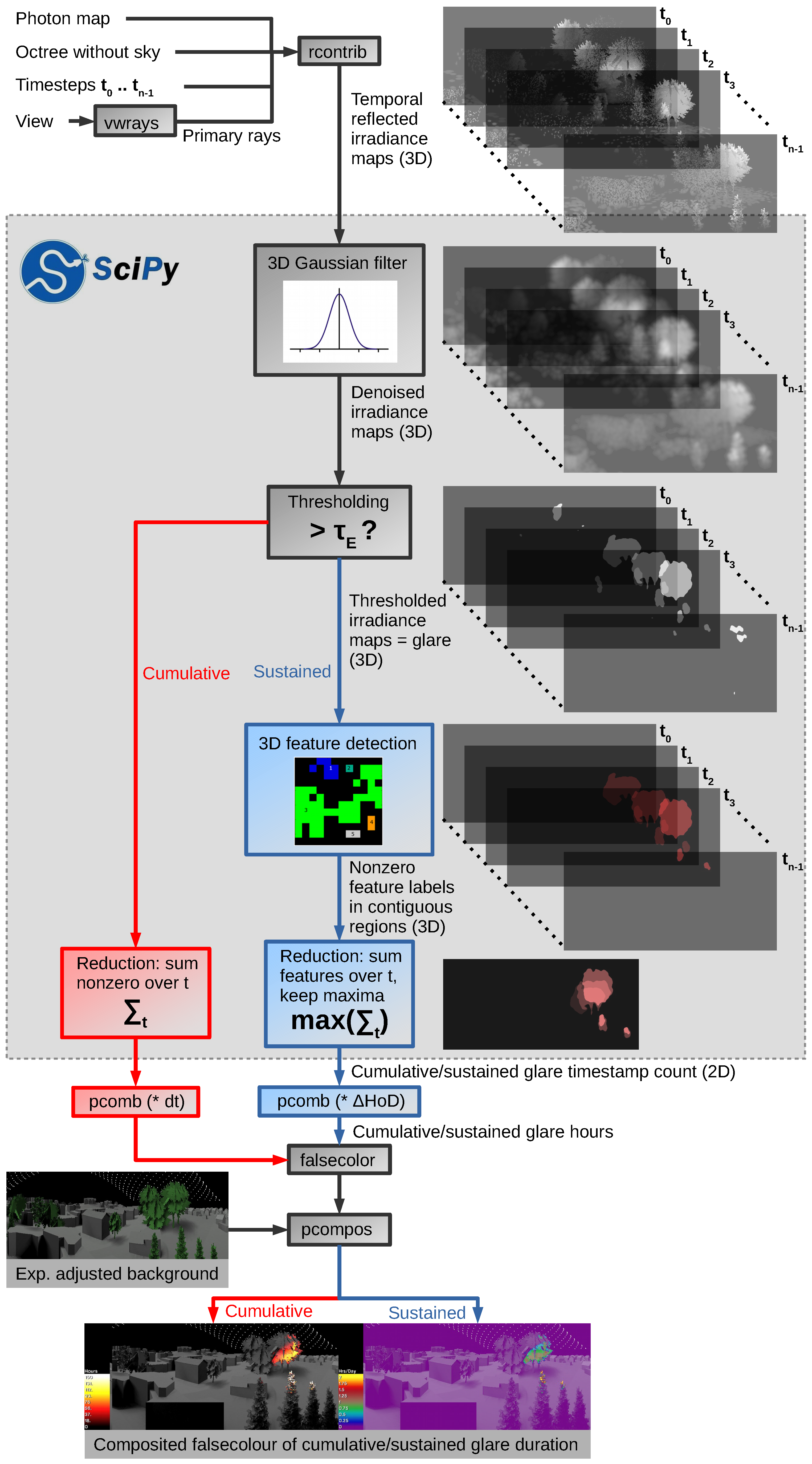
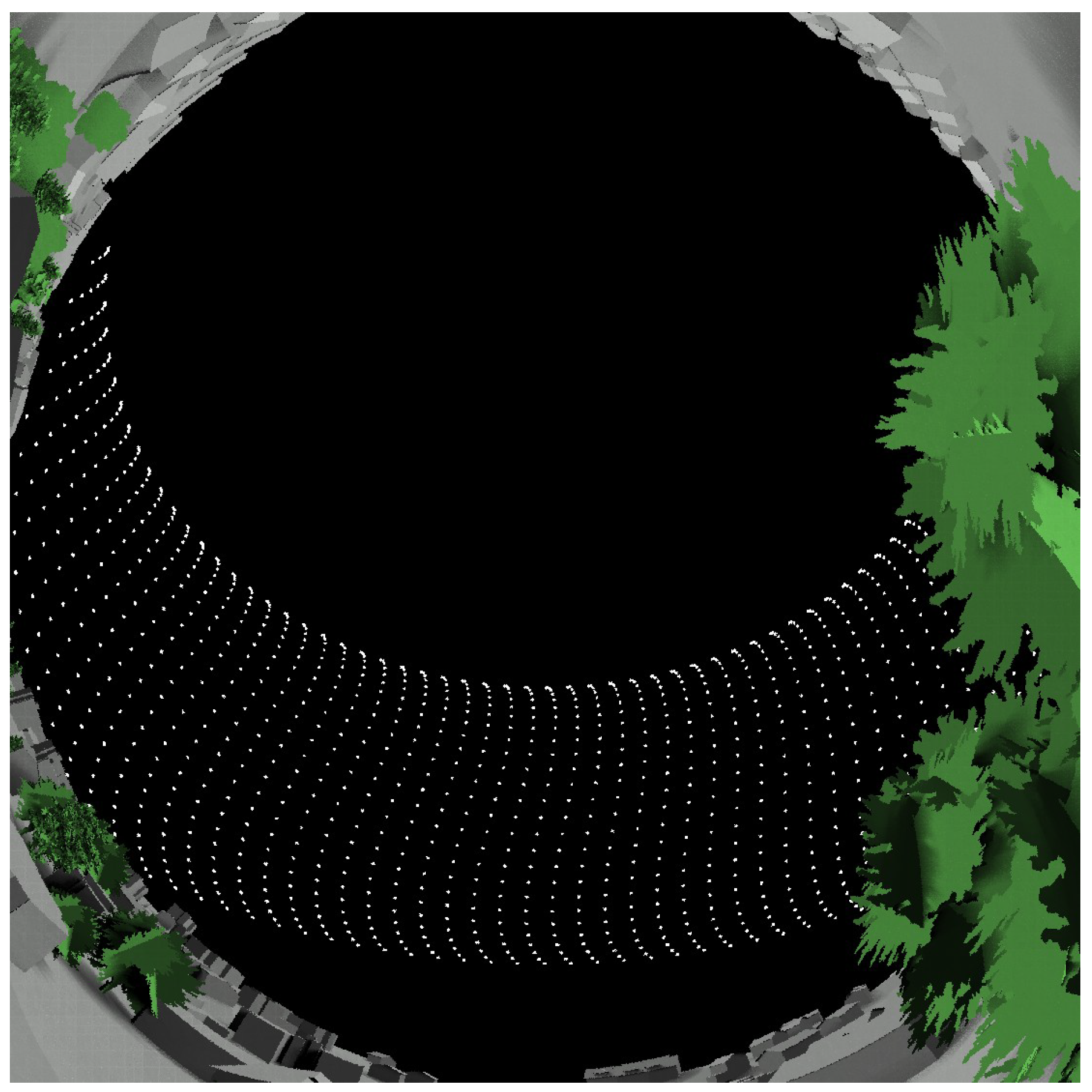
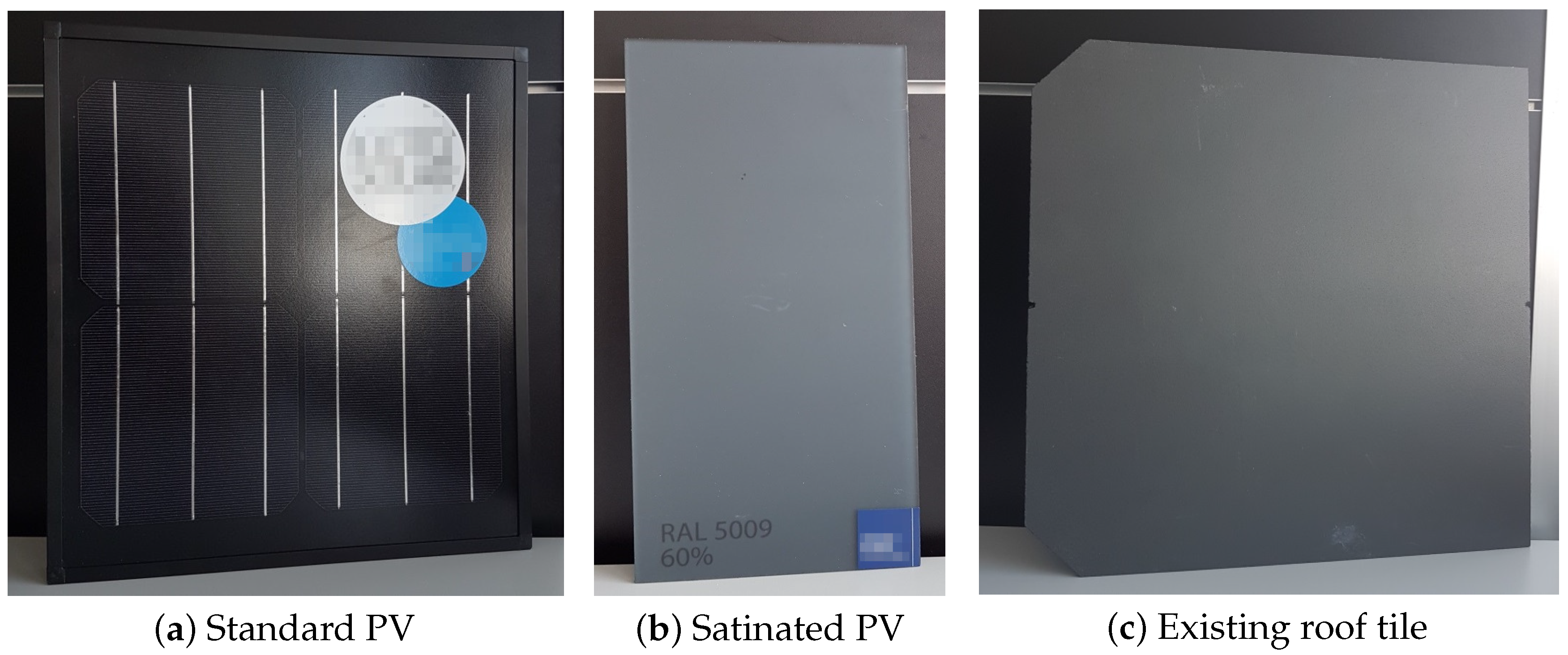

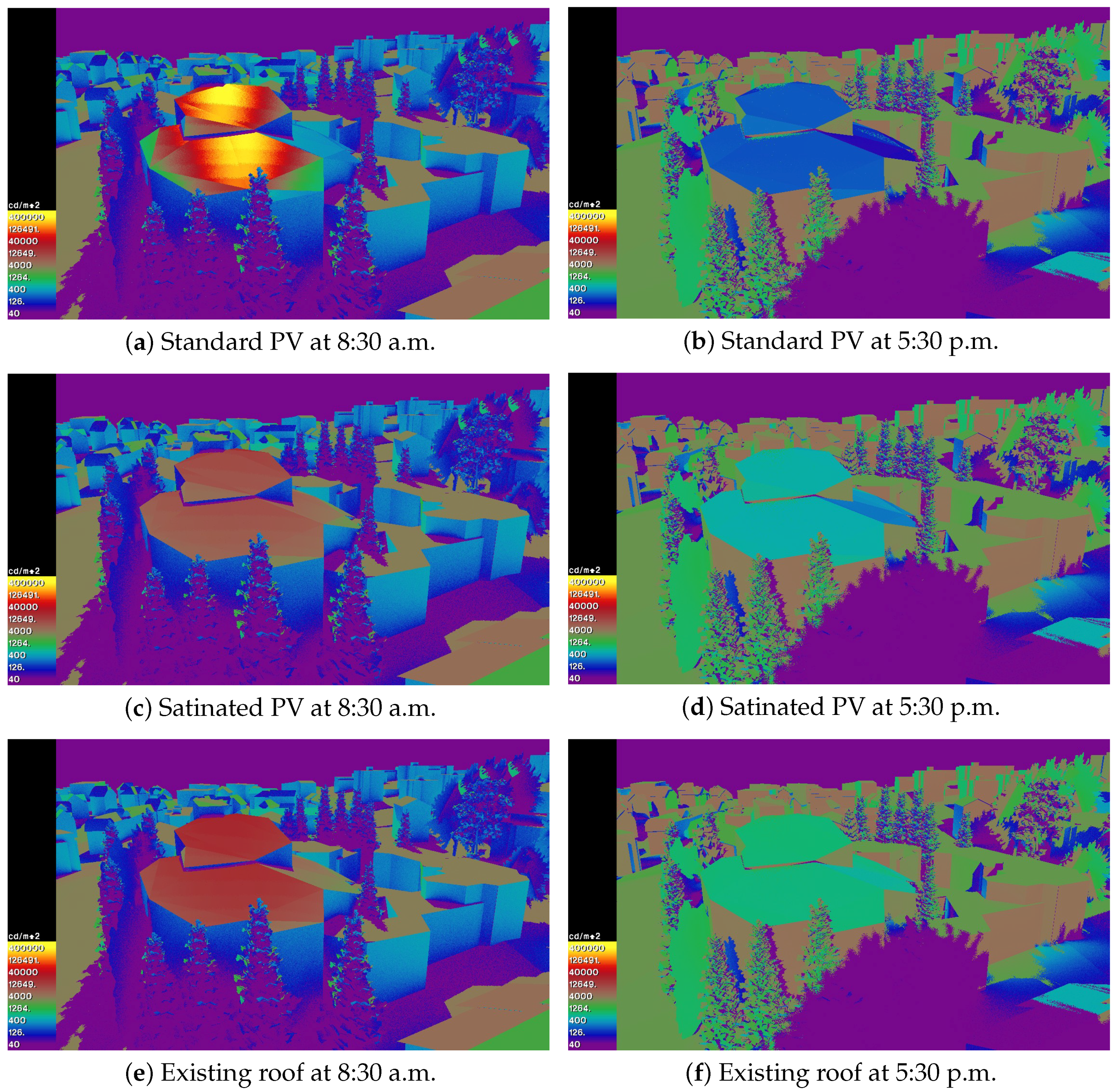
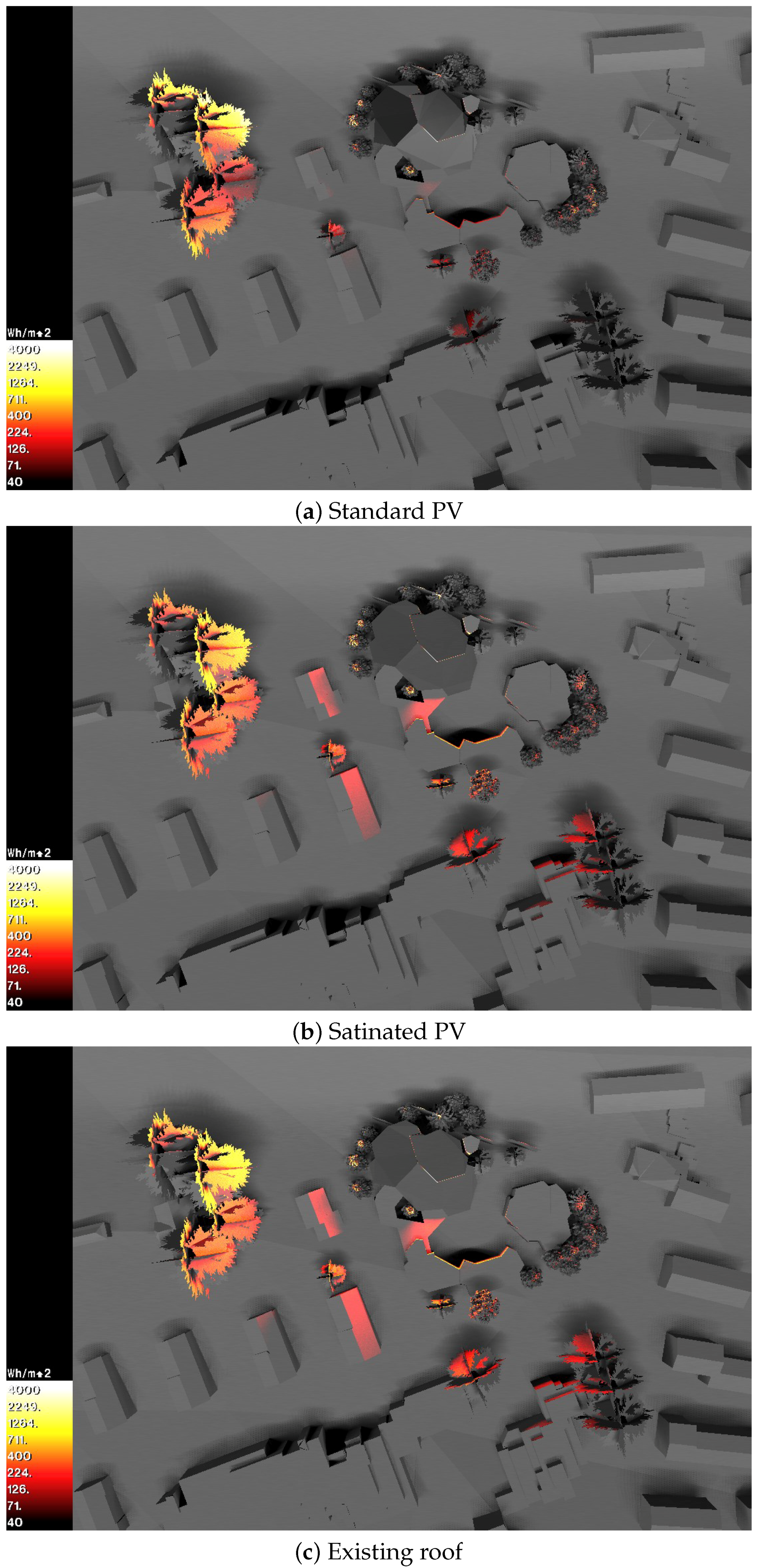
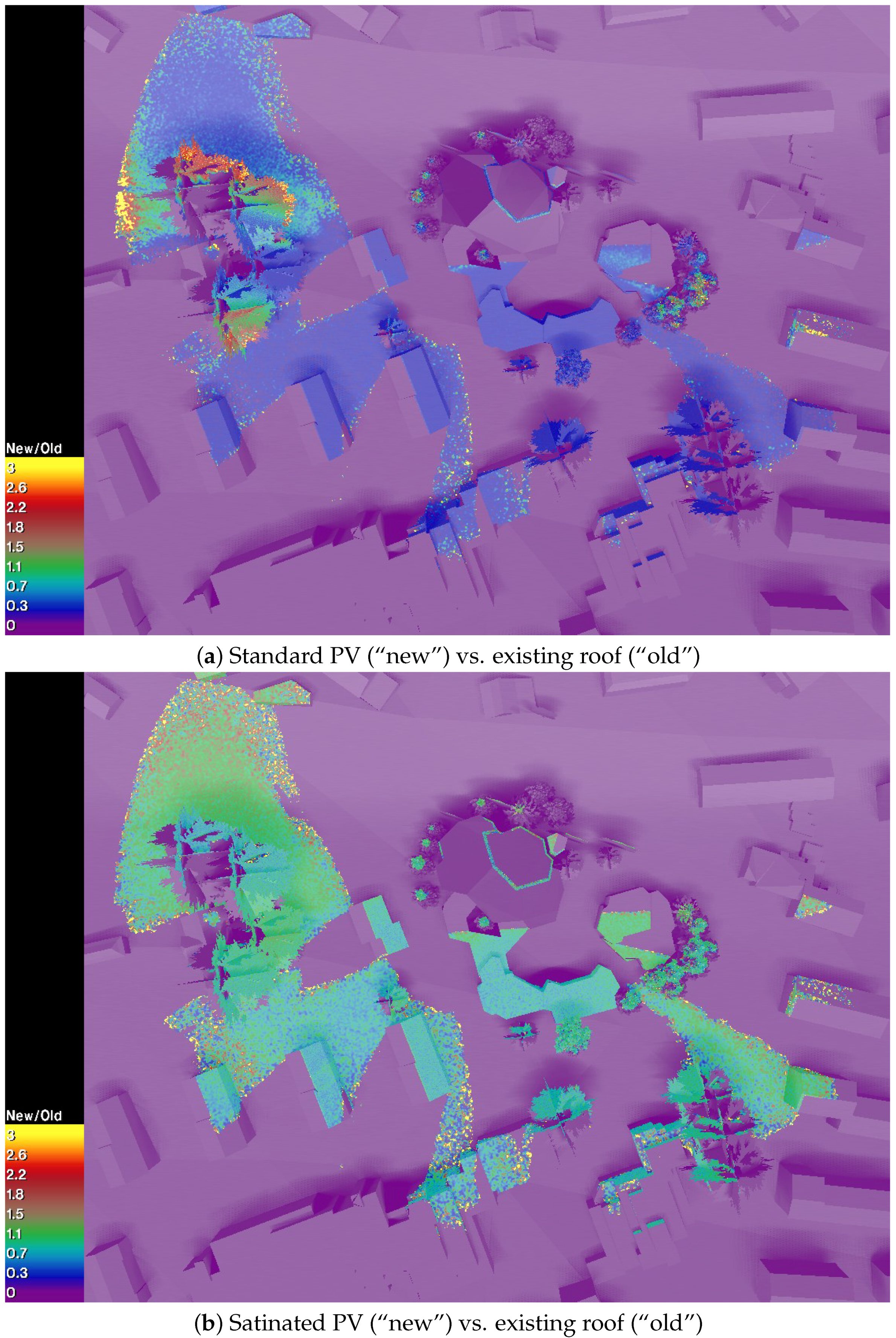
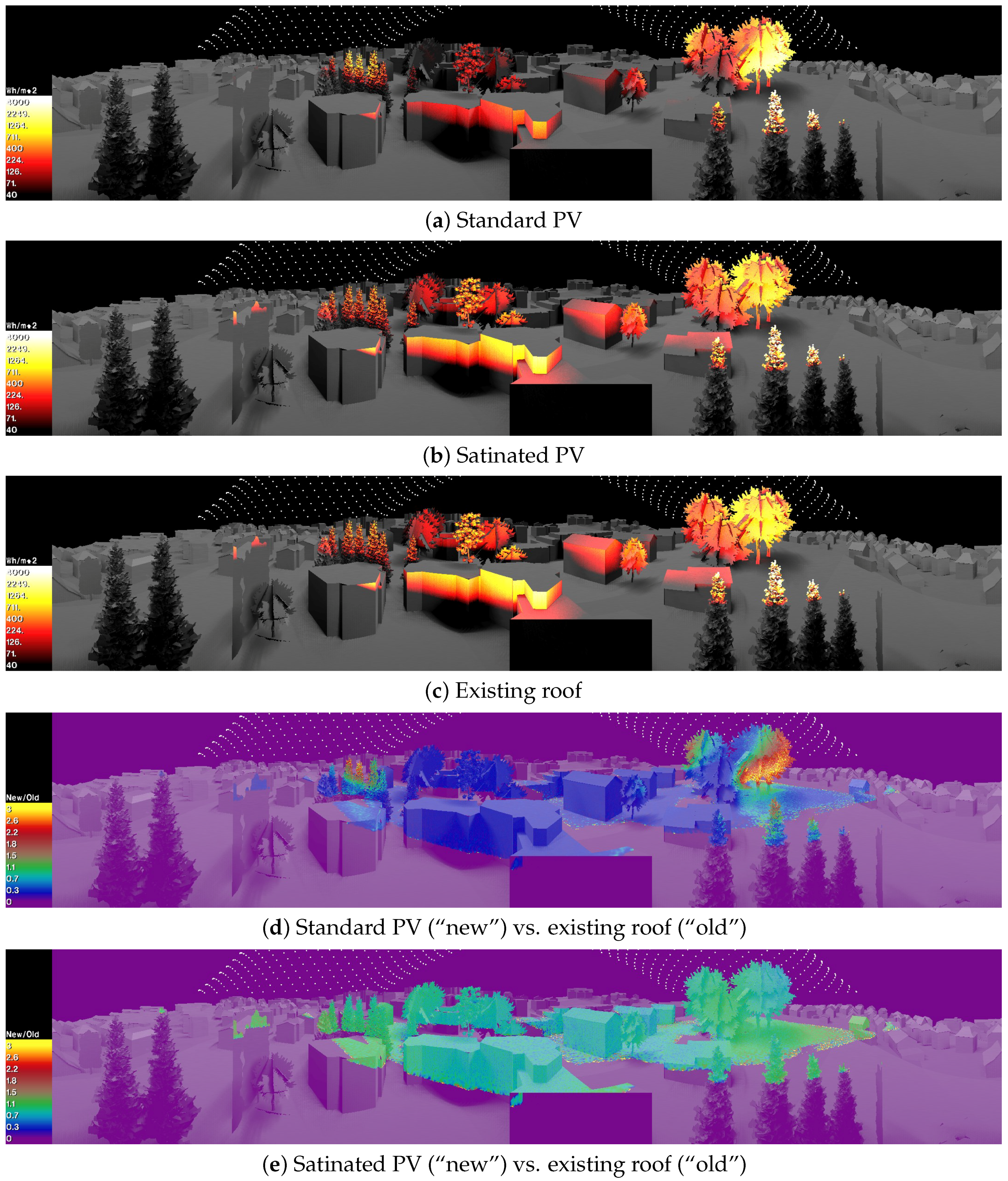
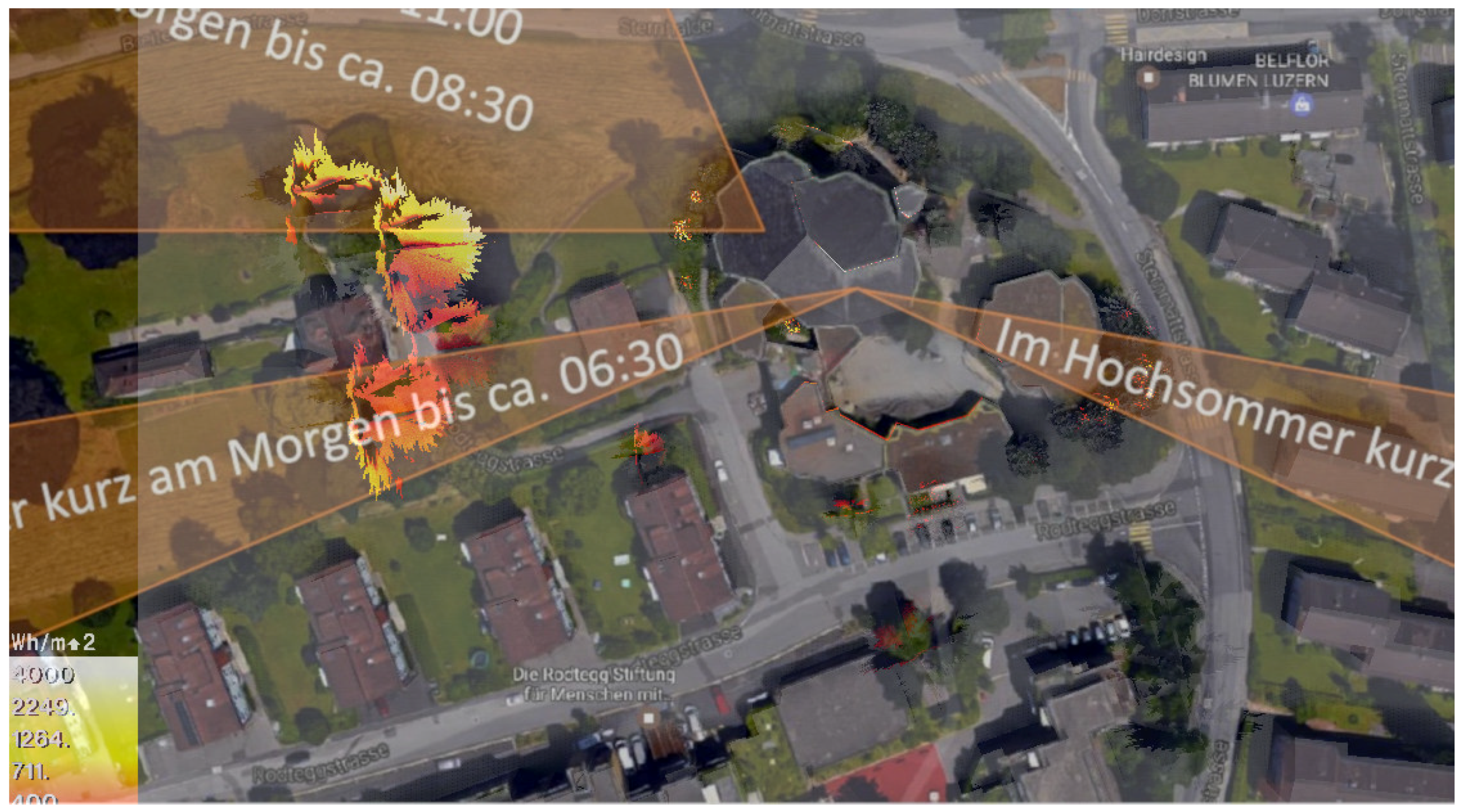
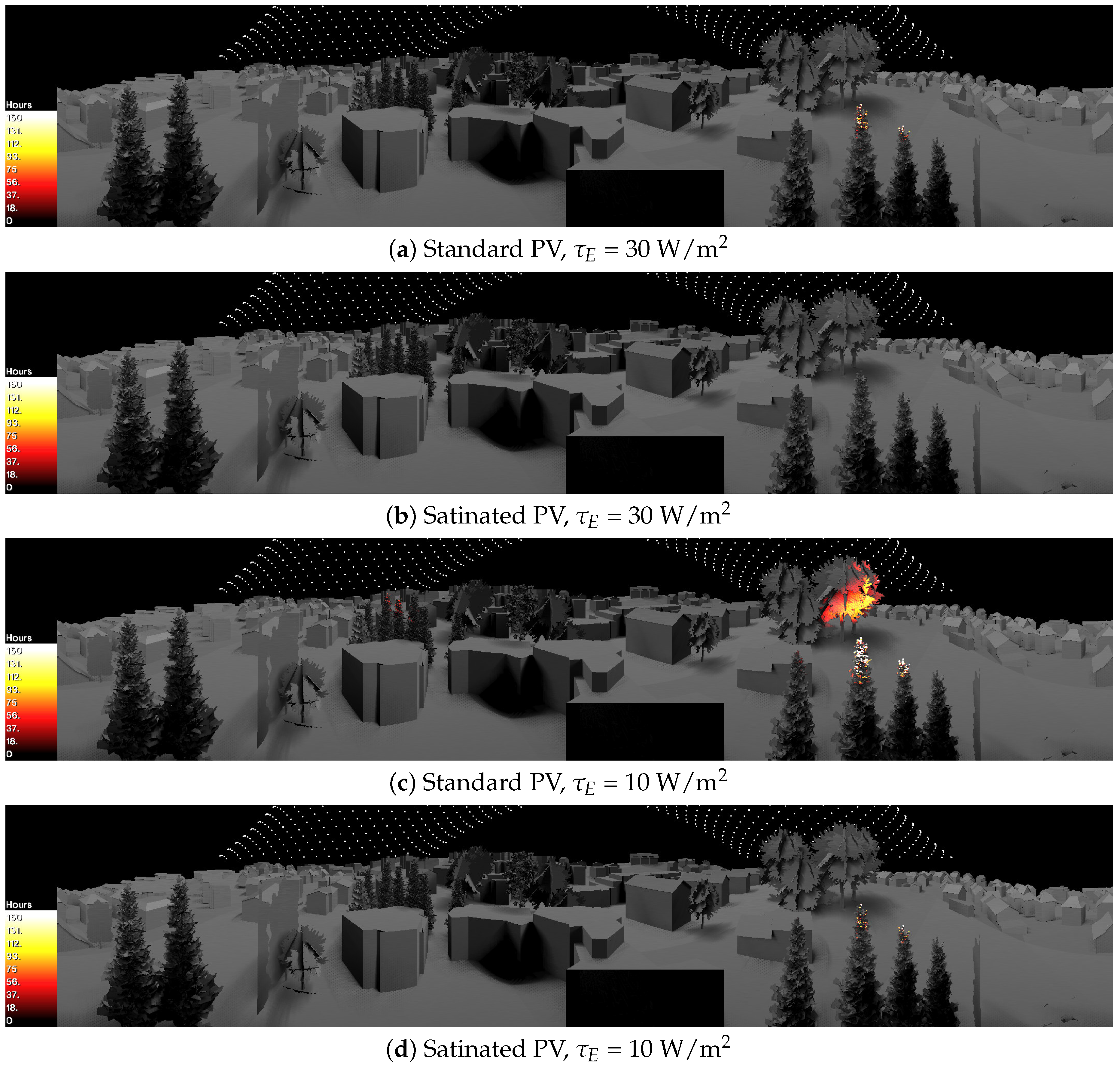
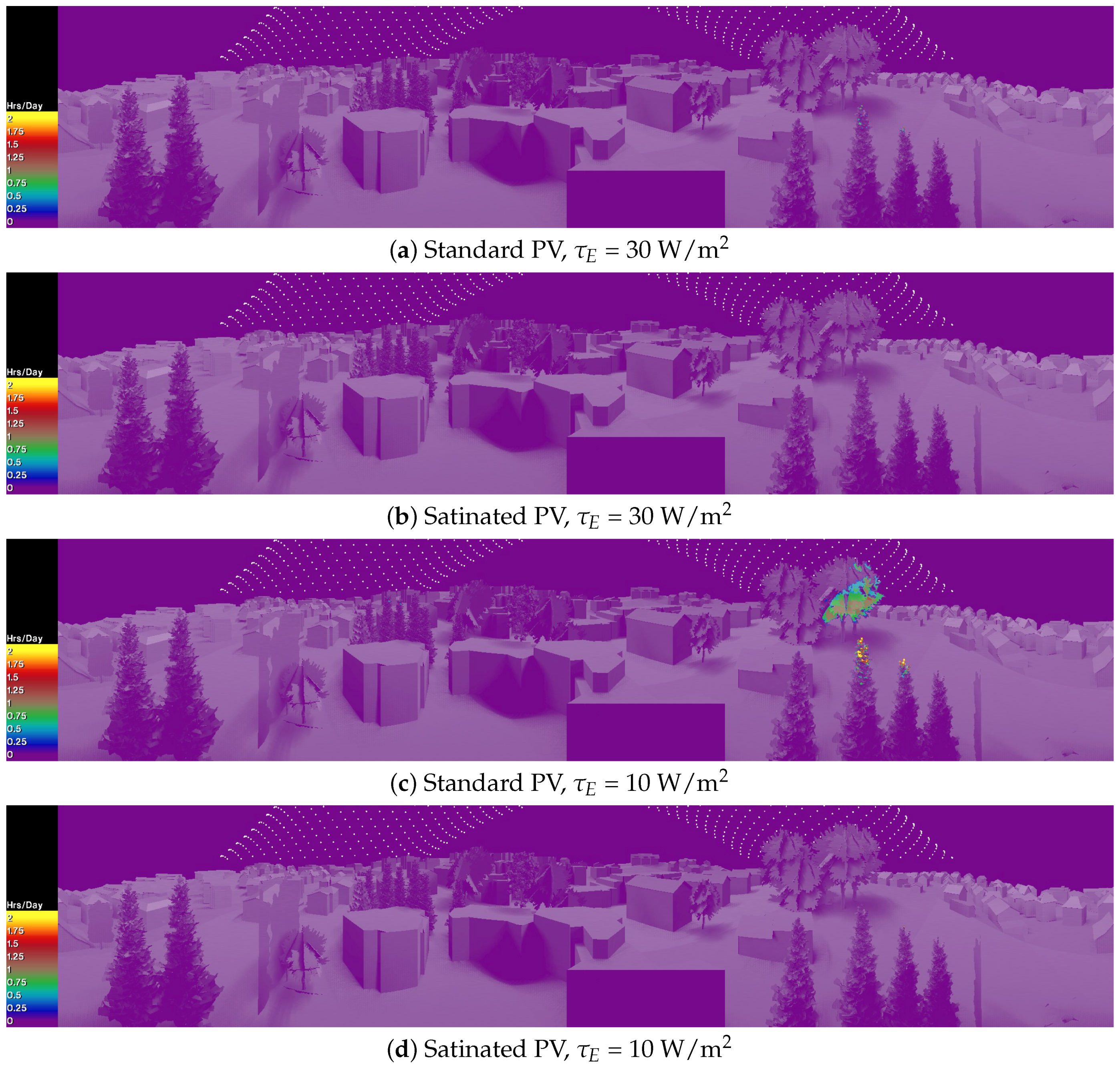
| Acronyms | |
| BAFU | Swiss federal environmental agency (Bundesamt für Umwelt) |
| BIPV | Building Integrated Photovoltaics |
| BSDF | Bidirectional Scattering Distribution Function |
| HDR | High Dynamic Range |
| LAI | German federal/state association for pollution control (Bund/Länder-Arbeitsgemeinschaft für Immissionsschutz) |
| PV | Photovoltaics |
| RPG | Swiss federal spatial planning law (Bundesgesetz über die Raumplanung) |
| RPV | Swiss federal spatial planning ordinance (Raumplanungsverordnung) |
| Radiance Tools | |
| falsecolor | Applies linear or logarithmic falsecolour scale to HDR image |
| genbsdf | Generates BSDF from measured data as XML file |
| gensky | Generates sky model for given date/time/location (solar position + optional sky dome) |
| mkpmap | Forward raytracer, generates photon map |
| oconv | Generates simulation model as octree (sky + geometry + materials) |
| pcomb | Modifies/filters HDR image pixels |
| pcompos | Composites multiple HDR images |
| pcond | Tone maps or adjusts exposure of HDR image |
| rcalc | Field-based calculator |
| rcontrib | Source/timestamp contribution raytracer, computes time-series irradiance from photons |
| rtrace | General backward raytracer, computes cumulative irradiance from photons |
| vwrays | Generates primary rays for a given viewpoint to pass into raytracer |
| Parameters [Units] | |
| DoY (ΔDoY) | Day of Year (resp. increment) [day] |
| HoD (ΔHoD) | Hour of Day (resp. increment) [h] |
| Maximum area of PV [m] | |
| Maximum distance to PV [m] | |
| Maximum reflected luminance from PV [cd/m] | |
| Maximum irradiance on receiver from PV [W/m] | |
| Maximum sustained glare duration on any day of the year [h] | |
| Maximum cumulative glare duration per year [h] | |
| Parameter, Critical Condition | Description | Threshold Value | Units |
|---|---|---|---|
| < | Distance to PV | 50 (commercial) 100 (residential) | m |
| > | Area of PV | 100 (commercial) 10 (residential) | m |
| > | Angle subtended by PV at receiver | 7.5 | °(degrees) |
| > | Reflected luminance from PV | 30 (MIT) 50 (Swissolar) | kcd/m |
| > | Irradiance from PV at receiver | 10 (Sandia Labs) ≈16.8 (MIT) 30 (Swissolar) | W/m |
| > | Maximum sustained glare duration on any day of the year | 30 | min |
| > | Cumulative glare duration per year | 50 | hours |
| Parameter | Description | Value |
|---|---|---|
| DoY | Day of year | [0, 181] |
| ΔDoY | Day of year increment | 7 |
| HoD | Hour of day | [4.5, 20.5] |
| ΔHoD | Hour of day increment | 0.25 |
| Number of timesteps (sun positions) | 1280 | |
| Lat, long | Site latitude, longitude | 47.038° N, 8.312° E |
| Merid | Timezone meridian | 15° E (CET) |
| Number of photons | 250 M | |
| Photon lookup bandwidth | 400 (rtrace), 4000 (rcontrib) |
© 2018 by the authors. Licensee MDPI, Basel, Switzerland. This article is an open access article distributed under the terms and conditions of the Creative Commons Attribution (CC BY) license (http://creativecommons.org/licenses/by/4.0/).
Share and Cite
Schregle, R.; Renken, C.; Wittkopf, S. Spatio-Temporal Visualisation of Reflections from Building Integrated Photovoltaics. Buildings 2018, 8, 101. https://doi.org/10.3390/buildings8080101
Schregle R, Renken C, Wittkopf S. Spatio-Temporal Visualisation of Reflections from Building Integrated Photovoltaics. Buildings. 2018; 8(8):101. https://doi.org/10.3390/buildings8080101
Chicago/Turabian StyleSchregle, Roland, Christian Renken, and Stephen Wittkopf. 2018. "Spatio-Temporal Visualisation of Reflections from Building Integrated Photovoltaics" Buildings 8, no. 8: 101. https://doi.org/10.3390/buildings8080101
APA StyleSchregle, R., Renken, C., & Wittkopf, S. (2018). Spatio-Temporal Visualisation of Reflections from Building Integrated Photovoltaics. Buildings, 8(8), 101. https://doi.org/10.3390/buildings8080101





